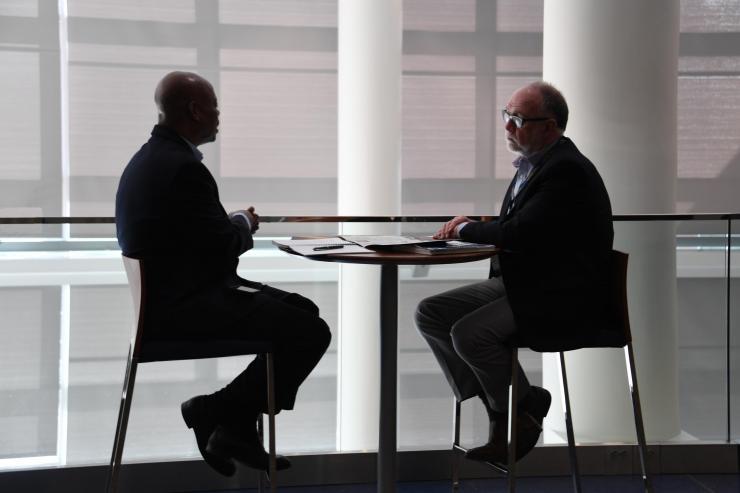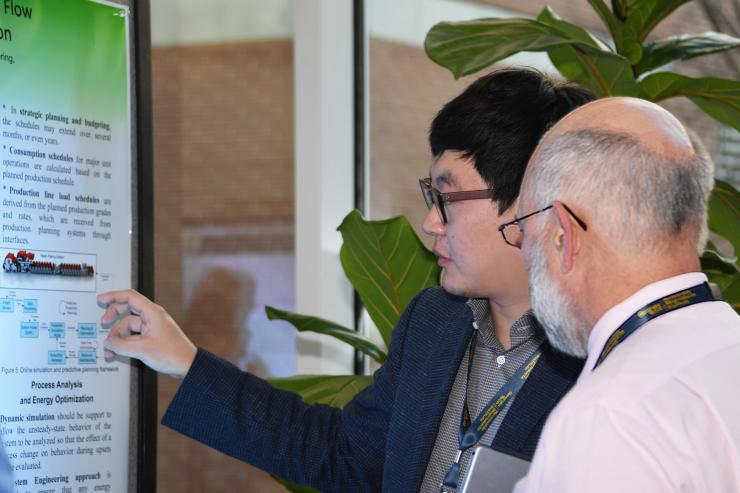Industry, researchers gather to discuss new technology paths in bioproducts manufacture
Mar 15, 2018 — Atlanta, GA

George White and Mike Rushton
Industry leaders recently took part in a dialogue with top researchers and students at Georgia Tech exploring new avenues of advanced manufacturing research that promises innovative solutions to long-standing challenges.
The Renewable Bioproducts Institute hosted its annual executive conference, “Transformative Opportunities for Bioproducts Manufacture,” March 6-7 on the Atlanta campus, and welcomed more than 150 attendees over two days. More information about the conference, including presentations, can be found on the RBI 2018 Executive Conference page.
RBI Executive Director Norman Marsolan kicked off the conference noting the increased enthusiasm of faculty for these types of conferences that afford one-on-one face time and an open platform for technology discussion with industry.
“Our faculty relishes such opportunities to understand the needs and challenges of manufacturing companies, and it helps calibrate their ideas going forward,” Marsolan said. “The opportunity for application of a range of cutting-edge tools to make a major difference is there for development.”
The conference was arranged in three sessions— Products, Processes and Reliability; Materials Innovation for the Advancement of the Paper and Chemical Industries; and Smart Manufacturing for Advancement of the Paper and Chemicals Industries. Each session featured faculty members offering opportunities in current research as well as what is developing on the horizon. Open dialogue between faculty and industry representatives during the sessions focused on bridging the disconnect between theoretical solutions and immediate needs.
Fibria Innovations’ Chief Operating Officer Mike Rushton was the highlighted speaker on Day 2, discussing his company’s strategy for expanding its success within the bioeconomy. The goals include profitability through productivity; growth through partnerships; and diversification into new products and businesses that leverage Fibria’s forest resources and industrial units. The company targets sizeable free cash flow from these new non-pulp business in the coming years.
“For example, eucalyptus is rich in lignin, and all of the extracted lignin is burned as fuel today,” Rushton said. “In a highly efficient mill, there is considerable excess energy which is exported as electric power. By finding higher-value uses for lignin, our mills can unload the recovery furnace, increase pulp production and create renewable bioproducts.”
Rushton added Fibria has defined several technology paths which support its biostrategy, in particular Pyrolysis, Lignin, and Nanocellulose. The way ahead, he said, is about more than just getting the technology right, however. It will require diversification into new businesses and formation of new partnerships, two strategies already under way at Fibria.
In other conference news:
- In addition to technical sessions, 46 graduate students showcased their research during a poster exhibition and contest.Member company representatives served as judges, considering the quality of research, clarity of presentation, and potential future commercial appeal.Winners were Jeffrey Luo, MSE; Nicholas Kruyer, ChBE; Chinmay Satam, ChBE; Bedi Baykal, MSE; Songcheng Wang, ChBE.
- Dirk Krouskop, president of the industry’s National Council for Air & Stream Improvement, celebrated his association’s upcoming 75th anniversary by revealing NCASI’s new brand and logo. “Our new brand’s three pillars represent impact, science, and solutions,” he said.“We welcome your engagement as we enter our next 75 years.”
- David Turpin gave an update on the Alliance for Pulp and Paper Technology Innovation (APPTI), formerly Agenda 2020, citing the strong partnership and support APPTI receives from RBI and Georgia Tech. “RBI is our most significant university partner for our growing portfolio of research — now surpassing $2 million — for breakthrough technology development,” he said.
- Steve Usselman, Georgia Tech professor of history and sociology, presented “Innovation Now & Then: Lessons from the Age of Invention,” sharing stories from throughout history of smaller start-up companies thriving among giant enterprises.
- The GT TAPPI Student Chapter organized a panel discussion for the conferees highlighting several collaborative research communities on campus (including Lignin Group and the Nanocellulose Group) through which RBI Graduate Fellows interact with a cross-section of students and faculty. One of those discussed is on nanocellulose, and another is on lignin.

Jungseob So, RBI Fellow, ChBE, and Peter Hart, Westrock, at the 2018 RBI Executive Conference.
kelly.smith@gatech.edu




